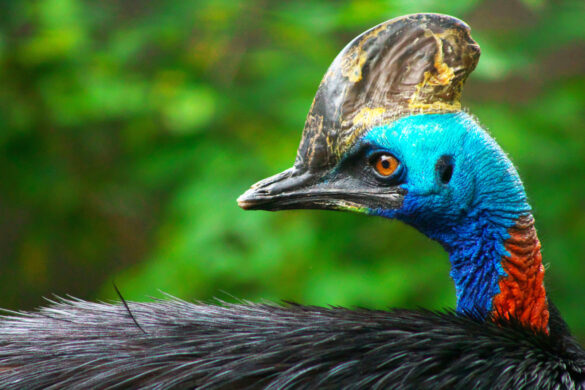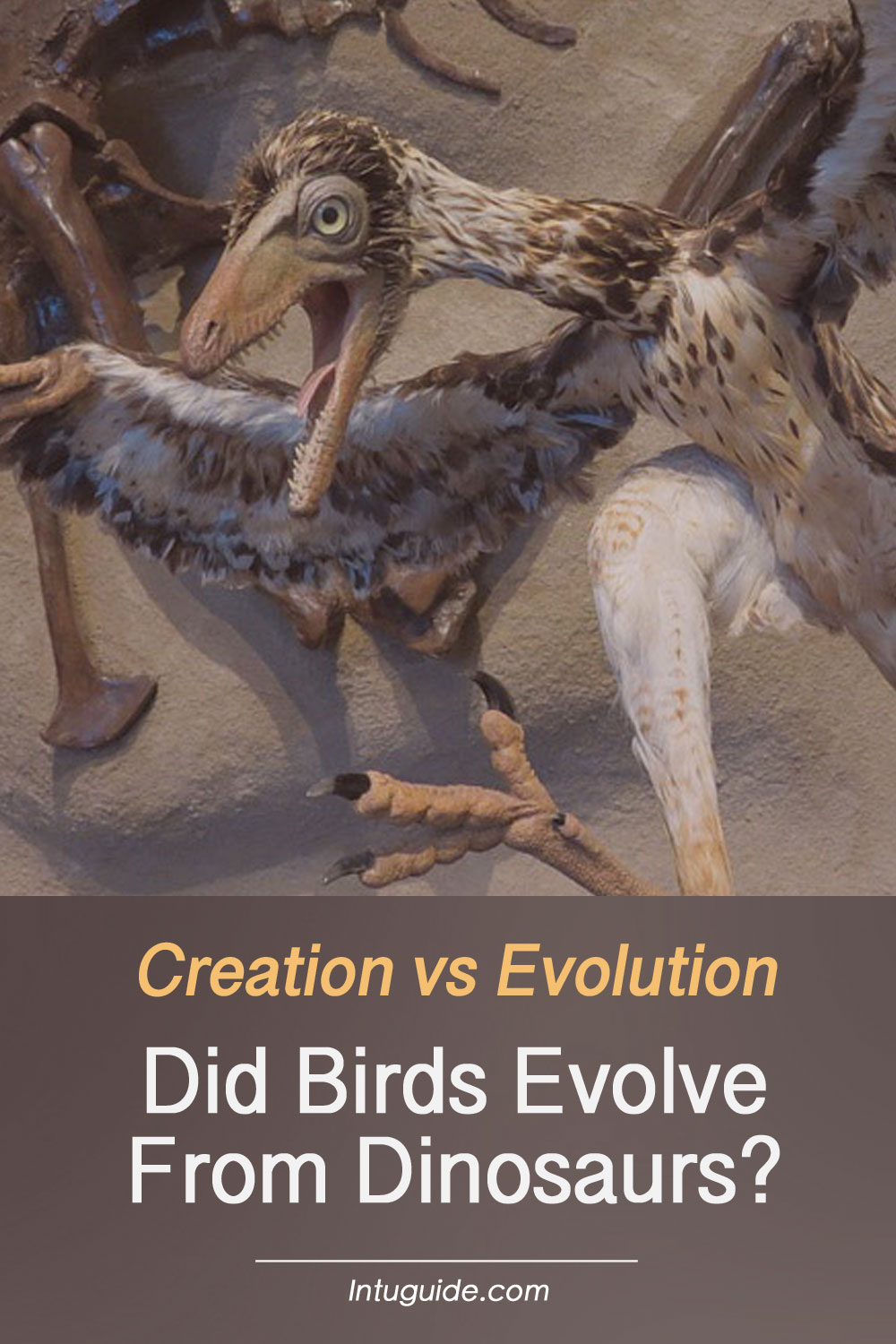Where did life on Earth come from? How did it get here? Did things appear according to the creation theory or did life come into existence all by itself. The theory of evolution implies that inanimate objects under some strange and unknown circumstances spontaneously gave birth to very primitive life forms. Evolutionists believe that humans, a relatively complex organism, evolved from simpler forms to complex forms of life for billions of years.
By investigating the findings of the feathered dinosaurs and the location from which the feathered dinosaurs originated, I will examine a missing link between reptiles and birds in greater depth in this article.
There is a famous theory out there explaining how the first primordial life was brought to Earth by comets or asteroids. This theory is known as the “panspermia” theory when simple life forms survive in their journey through the atmosphere and evolve into the species we see around us today. However, this theory is still untested.
The researchers admitted it can’t be proven because it is difficult to test without examining a large amount of space. It is rare to find a group of molecules required for life to develop and sufficiently high densities of chemical reactions to occur.
According to the Law of Biogenesis, simple live organisms can only come from another form of life that is already pre-existing. For example, bacteria and protozoa or any other kind of organism can only reproduce the same kind over and over. They can never come from non-living (inanimate) objects.
The cell needs all its basic parts with their various functions, for survival; therefore, if the cell had evolved, it would have meant that billions of parts would have had to come into existence at the same time, in the same place, and then simultaneously come together in a precise order (Origins?, Ranganathan, B.G., p. 15).
Any living cell comes from pre-existing cells because they are extremely complex and unable to survive without all the necessary components and basic parts.
Not a Missing Link
The missing link is a term used to describe transitional morphologies and fossil forms that are believed to bridge the evolutionary gap between higher primates (apes and monkeys) and humans.
The hominid fossils found in Africa were immediately assumed to be the missing link fossils and a possible immediate ancestor of humans. Evolutionists assumed that bones and artifacts from millions of years ago provide a precise historical record with evidence of how man evolved from simple organisms.
But it would be too simple to make any logical conclusion toward other related discoveries.
Many images of dinosaur and reptile fossils dating from 230 million to 65 million years ago display an approximate resemblance to smaller reptiles that are living today.
The Museum of Natural History exhibits archived fossils of evidence of a sudden, special creation of all life in a fully-formed condition. The fossil record shows that the variety of animals we see today appeared in the same form as they are today.
Archaeopteryx: A Bird or a Dinosaur?
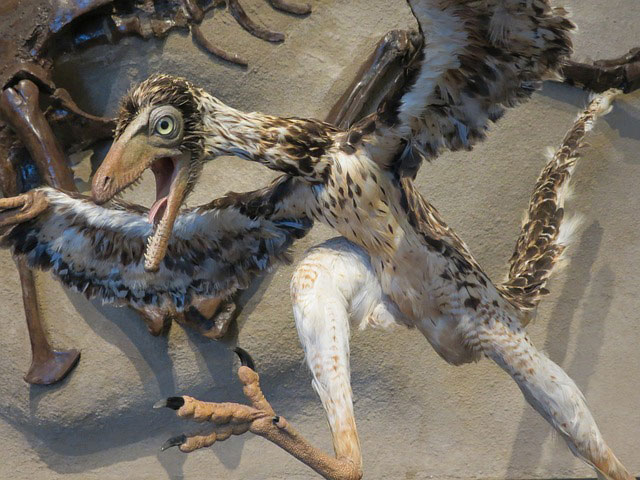
Image by Ron F. Pixabay
For many years, one theory dominated the world of paleontology: modern birds evolved from a wide-ranging group of dinosaurs called theropods. The “bird-dinosaur” fossils were proposed to be a missing link by National Geographic in 1999, which turned out to be a deliberately combined body of an early-toothed bird with the tail of a dinosaur.
The discovery of the first Archaeopteryx, half-reptile, half-bird, was assumed to be a missing link in 1861. It was found in southern Germany and studied thoroughly by European scientists. Some early researchers, such as Thomas Henry Huxley, immediately assumed that Archaeopteryx was the intermediate form or “missing link”.
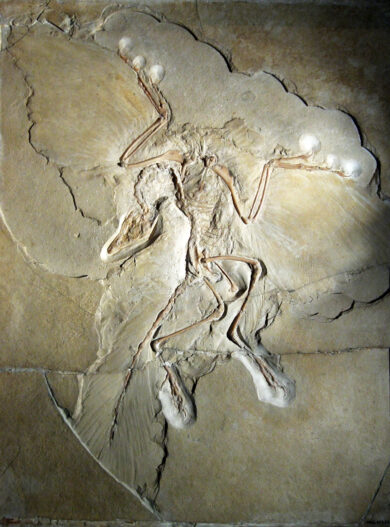
Archaeopteryx.
H. Raab/Vesta, CC BY-SA 3.0 via Wikimedia Commons
The Archaeopteryx species carried bird characteristics like feathers and wings. They also had the skeleton of a small theropod (flesh-eating) dinosaur, reptilian body parts with a long bony tail, teeth in the jaws, and fingers with claws on the edge of each wing.
Later, more skeletons of Archaeopteryx were found featuring similar traits. On top of that, new types of bird-like dinosaurs were discovered in China and Spain that were approximately 40 million years younger than Archaeopteryx.
They had short bony tails, and their hand claws were reduced to be more bird-like. As a result, evolutionists immediately assumed that not only did the Chinese localities discover amazing new birds, but also new dinosaur specimens with feathers.
The role of Archaeopteryx has been under debate since 1861. Is it a missing link between reptiles and birds? Evolutionists no longer considered Archaeopteryx as a single species in the evolutionary transition from reptiles to birds.
They placed Archaeopteryx on the evolutionary tree with many branches of countless theropod dinosaur lineages. They believed these lineages became more birdlike through time and then transitioned to fully-fledged birds.
This could become a nice dinosaur-to-bird evolution theory. However, according to new research, modern birds originated a hundred million years ago:
Modern birds originated a hundred million years ago—long before the demise of dinosaurs.
Researchers from Oregon State University discovered various physical inconsistencies between birds and dinosaurs and pointed out that birds fossils occurred before the dinosaurs from which they are supposedly descended:
Molecular studies suggest that the genetic divergences between many lineages of birds occurred during the Cretaceous period. This is because different lineages of birds can accumulate mutations at different rates, so applying a single rate to an entire family tree could lead to suspicious results. The study is the first rigorous investigation into whether bad assumptions about birds’ genetic data have led to the large difference—about 50 to 60 million years—between fossil- and genetic-based estimates.
Then, a recently discovered 99 million-year-old bird fossil made news in the world of paleontology. The squashed remains of a small bird were trapped inside amber found in Myanmar (Burma) and it is one of the oldest bird’s fossils known to science.
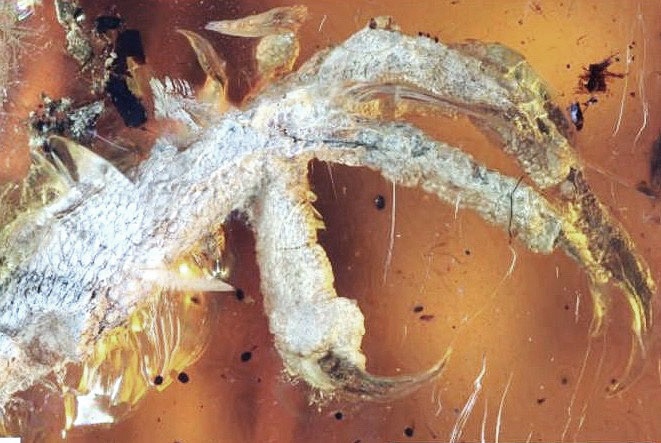
The 99 million-year-old appears to have been killed as it was hunting.
Image source: Elsevier / Gondwana Research
Julia Clarke, an expert on the evolution of birds and flight at the University of Texas at Austin, admitted:
This Myanmar fossil deposit is clearly game-changing. It’s arguably the more important breakthrough for understanding bird evolution right now. We used to think we’d never have a whole bird in Cretaceous amber, but now we have multiple examples
Fossils found in China added more diversity toward the early birds’ fossils. As a result, many researchers are no longer consider Archaeopteryx to be a bird, but rather a closely related group of feathered theropod dinosaurs.
Will Fish Start To Walk Soon?
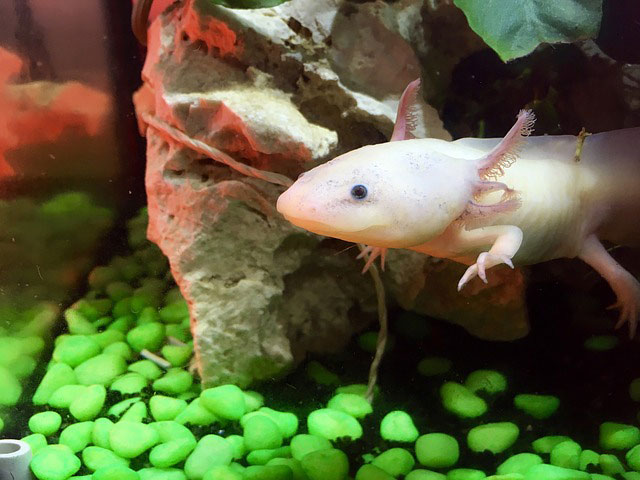
Image by uthlas from Pixabay
Nature-produced species that possess physical attributes that are normally present in other species. This type of species, however, was never called a “missing link” nor did they transform into a fish or a bird over time.
The axolotl, for example, has legs. Even though this Mexican salamander is called a “walking fish”, it is not a fish, but an amphibian. This type of species originated from numerous lakes and is considered to be very unusual among amphibians because they reach adulthood without undergoing metamorphosis. Instead of developing lungs and moving to the land, they remain in the water and have gills similar to fish.
Axolotls should not be confused with their close relatives, tiger salamanders. Nor should they be confused with fully aquatic salamanders that are not closely related to the axolotl but carry a superficial resemblance.
When researchers started to study species of swordtail fish in Mexican rivers about six years ago, they thought that hybrids are rare among animals. But fishes’ DNA has generic blueprints or a genome of different species’ DNA, indicating interbreeding with at least one other relative in the recent past.
Polly Campbell, an evolutionary geneticist at Oklahoma State University explains this hybridization process further:
Two species spend time apart adapting to separate environments, many changes accumulate in the species’ DNA. Such changes, or mutations, may alter the function or the structure of proteins produced by the genes. In a first-generation hybrid, those changes may not be visible. Parent species A’s genes produce cogs that fit its cellular machinery and Parent species B’s genes do the same. The hybrid inherits components to assemble fully functional versions of both parents’ machinery. But when hybrids go on to breed with each other, their offspring inherit different combinations of the original parent species’ genes. Sometimes that works out fine: A small proportion of the next generation may inherit all A machinery or all B machinery. Another proportion of offspring may get a mix of A and B cogs, but might be able to cobble together a biological machine that works well enough. A third segment of the offspring won’t be so lucky: They will be stuck trying to fit Species A’s cogs in an otherwise Species B machine (or vice versa), like a square peg in a round hole. Over time, enough offspring can inherit unworkable combinations of pegs and holes that the hybrids die out.
Researchers have discovered that birds, fish, fruit flies, mice, and other animals in nature carry DNA from parents of different species.
In 2010 there was another shocking discovery that early humans interbred with Neandertals and still carry the genes of their parents. This contradicts the ruling concept of biological species stating that separate species can’t mate and produce fertile offspring.
Environmental Factors
Some time ago, hundreds of eggs were discovered in China from winged reptiles called pterosaurs. The fossilized flying reptile, known as Pterodactyl had a wingspan of 52 feet. Newborn Pterodactyls were likely able to move around but were not able to fly, which means they were just feathered dinosaurs and not birds.
Pterodactyls, pterosaurs, and other similar creatures were able to live only in a specifically designed environment. There is no way such a creature could have flown with today’s atmospheric pressure, which is 14.7 pounds per square inch at sea level.
However, such a creature didn’t have any difficulty with the atmospheric pressure of around 32 pounds per square inch, with more oxygen in the atmosphere. This type of species was able to survive only in the ancient atmosphere found in the fossil record.
Some fossils revealed that dinosaurs of various sizes existed at the same time. Even though everything was larger in the past and species had more time to grow, large creatures didn’t appear in the same place at the same time. For example, the biggest dinosaurs such as theropods and plant-eating sauropods lived during the Cretaceous and the Jurassic periods (about 65 million to 200 million years ago).
A huge amount of giant mammals such as Uintatherium and Andrewsarchus appeared only forty-five million years ago. Elephant-sized ground sloths and wooly mammoths lived only during the last ice age which was about 12,000 to 5 million years ago.
Lineages of species change slowly or quickly over time and their development moves forward or backward. New lineages can appear through intermingling and the hybridization process and their development may progress or terminate depending on the condition of the environment and their role in nature.
Appearance of Trilobites
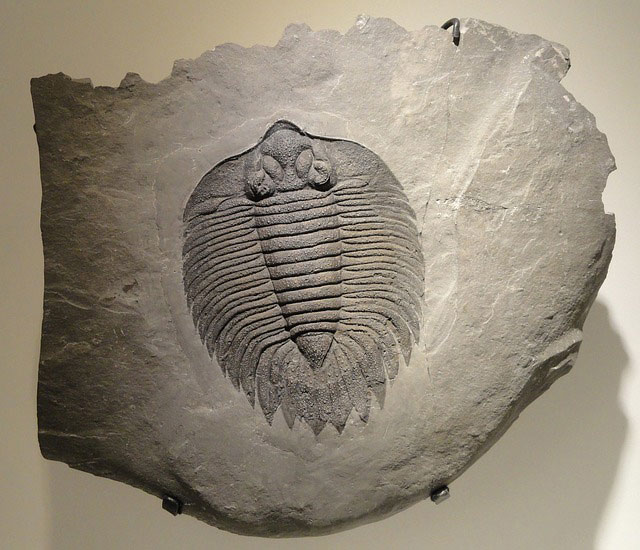
Trilobites fossils.
Image by Daderot, CC0, via Wikimedia Commons
One good example of a “sudden” creation is trilobites that used to live millions of years ago and left very detailed fossil records. Trilobites are a long-lasting group of extinct marine arachnomorph arthropods that first appeared nearly 521 million years ago in the Early Cambrian period.
Their fossil record indicates that throughout millions of years, their several lineages underwent mass extinction at the end of the Permian, about 252 million years ago, and then re-appeared again.
By the time trilobites first appeared in the fossil record, they were already geographically dispersed and highly diversified. In terms of evolutionary changes, trilobites didn’t change much over 252 million years. They re-appeared in their original form and didn’t evolve into a fish or a bird over time:
Early trilobites show all the features of the trilobite group as a whole; transitional or ancestral forms showing or combining the features of trilobites with other groups (e.g. early arthropods) do not seem to exist. Evidence suggests that significant diversification had already occurred before trilobites were preserved in the fossil record, easily allowing for the “sudden” appearance of diverse trilobite groups with complex derived characteristics (e.g. eyes)
Researchers noticed only minor changes necessary for adaptation to the specific environment which include developing new types of eyes, improvements in movement and articulation mechanisms, changes in the size of the pygidium, and the development of spinosity in certain groups.
Throughout the history of creation, various life forms appeared already pre-existed and didn’t generate from non-living (inanimate) objects. Over time, various species are continuously adapting to their environments and their survival depends on the environment they live in and the purpose they serve in the ecosystem as a whole.
Adaptation is not the same as the physical transformation from one group of species into a different group. The creation process is not a chaotic and twisted mass of diverging lines and broken wisps. It’s not some cloudy soup or blended mess of organisms that share (or do not share) certain traits at several different junctures.
It is impossible to create life without a life-giver, as it is impossible to create an embryo without an egg cell and sperm. An empty fish tank won’t fill itself with a wide variety of fish and reptiles.
As we can see in the example with the feathered dinosaurs, the creation process is intelligently planned and executed and includes a perfect order of organisms.
Different species are created to fill the specific ecological niches they inhabit. The fossil records give distinct evidence of one fact: the sudden, special creation of all life in a fully-formed condition.
*As an Amazon Associate, I earn from qualifying purchases.

